pawlowski6132,
You are no dummy. Nor a troll. I've read your posts before and they are thoughtful. Maybe you have been recently upset by some personal remarks, hope you can let it slide.
I get the feeling that in your heart you wish people could "feel" exposure and development in their bones, that it is all that is needed to solve their problems. And I would say you are right.
I cannot tell you how many years I knew the phrase "expose for the shadows, develop for the highlights" by heart without "getting it". I developed by time and temperature to the charts with ISO speed and without changing times from published data. I got really good negatives all along. Once in a while a thin frame was useless and it bugged me that I really didn't "know" what I was doing. Some really "important" shots of mine are just impossible to print. It's those bad negatives that drive me to want to control film.
Before I did a bit of testing, I never really learned to "feel" what it meant to expose sufficiently and develop for the right amount of time.
True, nowadays I do more testing than necessary. But that's one of my pleasures.
Many artists are frustrated by their medium, pencils don't draw what is in your mind without experience. Photography is special, you can get results quickly without really spending years of practice. But soon you reach a point where you don't get what you wanted. When you are frustrated and yearn to learn enough to regain the confidence that you had from the onset of your interest. This is where I believe the the Zone System (and it's corollary - film testing) base their appeal.
Many introductions to the Zone System state that by the end of the course, students will learn in a very short time what usually takes years of experience to acquire. I believe that.
So although it is hard work. Once it is done a student has made years of advancement. It's hard to tell how much time people will save in an Internet forum like this. Maybe it will take a year reading threads like these before a quick word helps show someone the light.
True, one need not do testing. So, padraigm, you have done a lifetime's worth already and you might get some value by developing another 4 minute sheet. But after that, you are ready to go back out and shoot.
 Hi All,
Hi All,











